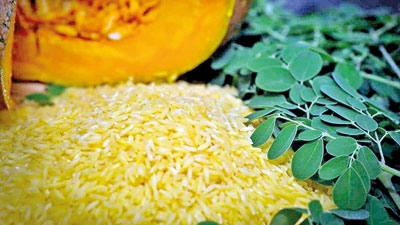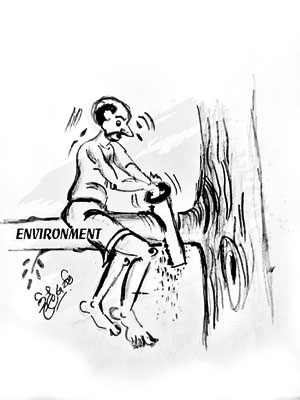Sunday Times 2
Global food demand by 2050: Meeting the challenges
The global food demand is projected to increase by 58 to 98 percent by 2050 given the global population increase from the present 7.5 billion to 9.7 billion. The impacts on natural resources, land, water and energy demand would be tremendous. The energy demand is predicted to increase by 80 percent, with the global economy four times larger than today. About 85 percent of the demand is expected to be met by fossil fuels, with increased greenhouse gas emissions leading to global warming.
Mitigating global warming, increasing investments in agricultural development, especially in new technology generation, as also minimising food waste are critical to meet the challenge of feeding the world by 2050.

Food security: Golden rice bred in Bangladesh to fight Vitamin A deficiency
Climate change
The ‘greenhouse effect’ that is predicted to raise global temperatures by about 1.4 to 4.5 degrees Celsius over the next six decades could lead to major weather changes globally. This effect is caused by absorption of radiation returning to the atmosphere by several gases chiefly carbon dioxide (CO2). The other gases involved are methane, nitrous oxide and chlorofluorocarbons, which, though prevalent in much smaller quantities in the atmosphere, are more potent than CO2. The greenhouse effect-related extreme weather impacts are predicted to seriously affect food production and productivity especially in the tropics.
Whereas extreme heat is likely to cause severe droughts in the dry areas with serious consequences on crop growth and yield, high intensity rainfall events would cause floods leading to soil erosion and other disruptions resulting in crop losses and other negative impacts. At the same time, global warming could cause a rise in sea-levels of more than one metre over the next fifty years risking life and property of half of the global population that lives in coastal areas.
On the other hand, warming of cold areas in countries extending to the northern latitudes such as China, Canada and Russia are forecasted to experience longer and warmer growing periods. Thus, they will benefit from climate change. In fact Russia might be the biggest benefiter. With such climatic trend, Russia should be able to re-farm its northern lands, no less than 40 million hectares, equal in size to Germany – the lands which it had abandoned following the dissolution of the Soviet Union in 1991. This may make Russia a far more economically powerful and politically authoritative country. However, this will necessitate, significant investments in agriculture and rural infrastructure.
Iceland and Finland are also set to benefit from such climate change. Warming should enable expansion of pasture lands, hay and other crop production systems in the two countries. The rice production in Japan is predicted to soar leading to surpluses and necessitating revisions in rice support and trade policies.
 However, the losses globally would outweigh benefits because of the likely severe negative impacts especially in both the humid and dry tropics.
However, the losses globally would outweigh benefits because of the likely severe negative impacts especially in both the humid and dry tropics.
For many developing countries, a near doubling of the population and, concurrently a loss of one sixth of the cropland by 2050 are predicted due to vagaries of the climate. Mitigating climate change, therefore, is of paramount importance particularly for the tropical third world countries.
Mitigating climate change
Promoting alternative energy strategies that can replace fossil energy is critically important. There is much interest in alternative energy sources such as solar, wind and water, but the overall shift is not satisfactory.
Carbon dioxide accounts for 60-70 percent of the overall greenhouse gas emissions. Forests and vegetation in general are important in climate change mitigation as they sequester CO2.
Tropical forest destruction, especially the rainforests, is a matter that needs more firm addressing. Vast extents of the Amazon forests, considered the ‘lung of the world’ have already been opened up for agriculture and other purposes. Similarly the large tracts of the East Asian rainforests in countries such as Malaysia, Indonesia and the Philippines have been opened up, largely for agriculture. In this regard growing tree crops such as rubber and oil palm is ‘grudgingly’permissible at least in terms of carbon sequestration as their rates are comparable to that of rainforests. The issue, however, is that large tracts have been opened up also for industries, human settlements and arable cropping.
About 5-10 percent of methane, the second most important greenhouse gas, leaks from natural gas systems. The other sources are livestock, and flooded rice fields and animal manure stored for long periods in lagoons and tanks. Nitrous oxide and fluorinated gases account for about 5 percent of the greenhouse gases and are generated from human activities, applied nitrogen fertiliser and industries. Although there is some degree of mitigation intervention, the impacts are inadequate.
Minimizing food waste
Reducing food wastage is a critical need to meet the food demand.
Wastage occurs right across the entire food chain from producer to the consumer and is reported to account for about 30-40 percent particularly in the third world countries, where it is least affordable.
Much of this wastage occurs during haulage. Governments should address the issue of safe storage and haulage as a matter of highest priority.
New agricultural technologies
Many countries and international agricultural research institutes have launched research and development (R&D) programmes to meet the challenges of global warming. Since the inception of the Green Revolution in the 1960s, globally, the grain yields with conventional breeding technologies, have been increasing. In Sri Lanka and in many other countries, they have increased by tenfold or more over the past 50 years.
However, there is the likelihood of yields ‘plateauing’ with conventional technologies in the future. Thus, there is a need for recourse in other technologies such as genetically modified (GM) or transgenic crop breeding. At the same time improving soil and water management is critically important.
Transgenic crops
There were only 1.6 million hectares of GM crops globally in 1996 which increased tenfold over the next two decades, and now stand at 1.4 billion hectares or 10 percent of the global arable land. Serious concern, however, has been expressed by some on their impact on biodiversity as a result of crossing with compatible indigenous species and producing ‘competitive’ traits that may multiply faster than indigenous species.
However, many experts, including the British Royal Society, consider GM crops as altogether safe, and cause no more damage to the environment than conventional ones. There are, however, some 29 countries that have rejected GM crops. They include Sri Lanka. Nevertheless we do not know what we eat by way of imported food. Nearly all the soya meat that we consume is imported and much of it could be GM. It is the view of many scientists that with increasing knowledge in gene transfer across varieties and species, negative impacts could be substantially reduced; and GM crops will play a key role in meeting the future food challenges.
Investments in R&D
In conclusion, there is a need for far more investments in R&D to meet the future food demand, especially of developing countries. Whereas developed countries on average invest over 2 percent of the GDP, most developing countries invest far less. For example, India spends nearly 1 percent whereas we, a meagre 0.3 percent.
Sri Lanka spends nearly the least in Asia, even below Bangladesh and only just above Nepal! Our institutes, including the Department of Agriculture (DOA), are drastically depleted of resources, especially qualified staff both due to vertical and lateral brain drain, the latter being more serious now. Universities pay nearly double the salary to a qualified researcher as against R&D institutions. The result is an exodus of researchers to the universities. The Government’s intervention to redress the situation is urgently needed.

